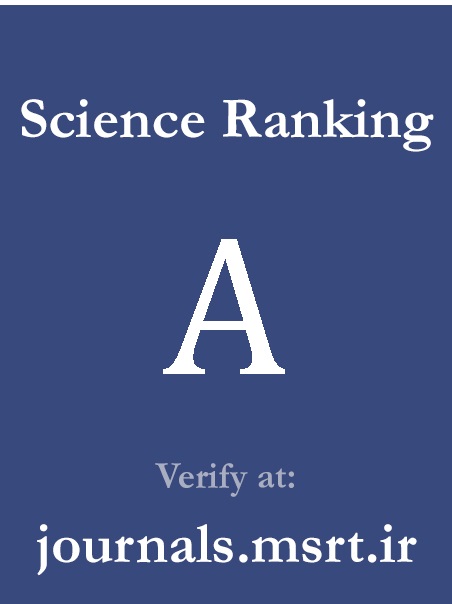Explaining the Structural Model of Health Anxiety Based on Metacognitive Beliefs with the Mediating Role of Anxiety Sensitivity in Individuals with Obsessive–Compulsive Symptoms
Keywords:
health anxiety, metacognitive beliefs, anxiety sensitivity, obsessive–compulsive symptomsAbstract
Purpose: The present study aimed to clarify a structural equation model of health anxiety based on metacognitive beliefs, with anxiety sensitivity serving as a mediator among individuals with obsessive–compulsive symptoms.
Methods and Materials: This descriptive–correlational research utilized structural equation modeling. The statistical population consisted of all individuals exhibiting obsessive–compulsive symptoms who attended counseling centers, psychological clinics, and psychiatric clinics in Isfahan during 2024–2025. A convenience sample of 480 participants was selected. The research instruments included the Short Health Anxiety Inventory (SHAI) developed by Salkovskis and Warwick, the Metacognitions Questionnaire-30 (MCQ-30) by Wells and Cartwright-Hatton, and the Anxiety Sensitivity Index (ASI) by Floyd et al. Data analysis was performed using SPSS and AMOS software, and structural equation modeling with bootstrapping was applied to test the hypotheses.
Findings: The findings revealed that all direct paths among the study variables were statistically significant at p < 0.05. Anxiety sensitivity significantly mediated the relationship between metacognitive beliefs and health anxiety. The bootstrap analysis indicated that the indirect effect of metacognitive beliefs on health anxiety was 0.141, which was significant at the 0.05 level.
Conclusion: The results demonstrated that dysfunctional metacognitive beliefs contribute to the development of health anxiety by heightening anxiety sensitivity. Consequently, modifying maladaptive metacognitive beliefs and implementing interventions aimed at reducing anxiety sensitivity—such as interoceptive exposure and symptom reappraisal—can play a vital role in managing and alleviating health anxiety among individuals with obsessive–compulsive symptoms.
Downloads
References
Bailey, R., & Wells, A. (2013). Does metacognition make a unique contribution to health anxiety when controlling for neuroticism, illness cognition, and somatosensory amplification? Journal of Cognitive Psychotherapy, 27(4), 327-337. https://doi.org/10.1891/0889-8391.27.4.327
Bailey, R., & Wells, A. (2015). Metacognitive beliefs moderate the relationship between catastrophic misinterpretation and health anxiety. Journal of anxiety disorders, 34, 8-14. https://doi.org/10.1016/j.janxdis.2015.05.005
Bulut, S., Saadati, N., Al-Dossary, S. A., Coelho, O., Rostami, M., Parsakia, K., Zadhasn, Z., Seyed Ali Tabar, S. H., & Mehdi Abadi, P. (2025). Introspective Awareness and Its Predictive Power on Health Anxiety: A Cross-sectional Study. Journal of Research and Health, 15(1), 71-80. https://jrh.gmu.ac.ir/article-1-2529-fa.html
Chiu, H., Low, D., Chan, A., & Stedman, R. (2024). Relationship between anxiety sensitivity and post-traumatic stress symptoms in trauma-exposed adults: A meta-analysis. Journal of anxiety disorders, 103. https://doi.org/10.1016/j.janxdis.2024.102857
Cookson, C., Luzon, O., Newland, J., & Kingston, J. (2020). Examining the role of cognitive fusion and experiential avoidance in predicting anxiety and depression. Psychology and Psychotherapy: Theory, Research and Practice, 93(3), 456-473. https://doi.org/10.1111/papt.12233
Fergus, T. A. (2013). Repetitive thought and health anxiety: Tests of specificity. Journal of psychopathology and behavioral assessment, 35(3), 366-374. https://doi.org/10.1007/s10862-013-9340-y
Floyd, M., Garfield, A., & Marcus, T. (2005). Anxiety sensitivity and worry. Personality and individual differences, 38(6), 1223-1229. https://doi.org/10.1016/j.paid.2004.08.005
Foroughi, A. A., Mohammadpour, M., Khanjani, S., Pouyanfard, S., Dorouie, N., & Parvizi Fard, A. A. (2019). Psychometric properties of the Iranian version of the Anxiety Sensitivity Index-3 (ASI-3). Trends in Psychiatry and Psychotherapy, 41(3), 254-261. https://doi.org/10.1590/2237-6089-2018-0078
Haig-Ferguson, A., Cooper, K., Cartwright, E., Loades, M. E., & Daniels, J. (2021). Practitioner review: Health anxiety in children and young people in the context of the COVID-19 pandemic. Behavioural and Cognitive Psychotherapy, 49(2), 129-143. https://doi.org/10.1017/S1352465820000636
Hovenkamp-Hermelink, J. H. M., van der Veen, D. C., Oude Voshaar, R. C., Batelaan, N. M., Penninx, B. W. J. H., Jeronimus, B. F., Schoevers, R. A., & Riese, H. (2019). Anxiety sensitivity, its stability and longitudinal association with severity of anxiety symptoms. Scientific reports, 9(1), 4314. https://doi.org/10.1038/s41598-019-39931-7
Kaur, A., Butow, P., & Thewes, B. (2011). Do metacognitions predict attentional bias in health anxiety? Cognitive therapy and research, 35(6), 575-580. https://doi.org/10.1007/s10608-011-9387-6
Keen, E., Kangas, M., & Gilchrist, P. T. (2022). A systematic review evaluating metacognitive beliefs in health anxiety and somatic distress. British Journal of Health Psychology, 27(4), 1398-1422. https://doi.org/10.1111/bjhp.12609
Lenzo, V., Sardella, A., Martino, G., & Quattropani, M. C. (2020). A systematic review of metacognitive beliefs in chronic medical conditions. Frontiers in psychology, 10, 2875. https://doi.org/10.3389/fpsyg.2019.02875
Majidazar, A., Mohammadi, H., Panahi, F., & Hashemi Nosrat Abadi, T. (2023). The relationship between anxiety sensitivity and health anxiety: The mediating role of distress tolerance. Journal of New Ideas in Psychology, 19(23), 1-9. https://jnip.ir/browse.php?a_id=1083&slc_lang=en&sid=1&printcase=1&hbnr=1&hmb=1
Nargesi, F., Izadi, F., Kariminejad, K., & Rezaei Sharif, A. (2016). Investigating the validity and reliability of the Persian version of the Health Anxiety Questionnaire among students of Lorestan University of Medical Sciences. Educational Measurement Quarterly, Allameh Tabataba'i University, 8(27). https://jem.atu.ac.ir/article_7948.html
Norbye, A. D., Farbu, E. H., Terjesen, C. L., Fleten, N., & Höper, A. C. (2023). The level of health anxiety before and during the COVID-19 pandemic. PLoS One, 18(5), e0285799. https://doi.org/10.1371/journal.pone.0285799
Otmar, C. D., & Merolla, A. J. (2025). Social determinants of message exposure and health anxiety among young sexual minority men in the United States during the 2022 mpox outbreak. Health Communication, 1-12. https://doi.org/10.1080/10410236.2024.2397272
Polat, K. (2025). Relationships Between Health Anxiety, Intolerance of Uncertainty, Rumination and Self-Compassion: A Structural Equation and Latent Profile Analysis. International Journal of Eurasia Social Sciences, 16(59), 290-313. https://doi.org/10.70736/ijoess.552
Rajezi Esfahani, S., Motaghipour, Y., Kamkari, K., Zahiredin, A., & Janbozorgi, M. (2012). Reliability and validity of the Persian version of the Yale-Brown Obsessive-Compulsive Scale (Y-BOCS). Iranian Journal of Psychiatry and Clinical Psychology, 17(4), 297-303. https://www.sid.ir/paper/16598/en
Shirinzadeh Dastgiry, S., Goudarzi, M. A., Rahimi, C., & Naziri, G. (2008). The study of factor analysis, validity and reliability of Metacognition Questionnaire-30. Journal of Psychology, 12(48), 445-461. https://sid.ir/paper/54377/en
Soleimani Babadi, F., Kalivand, M., Derakhshani, M., Saki Darbashi, F., & Nemati, Z. (2022). The role of anxiety sensitivity components, intolerance of uncertainty, and health-related metacognitive beliefs in predicting health anxiety.
Stein, D. J., Costa, D. L., Lochner, C., Miguel, E. C., Reddy, Y. J., Shavitt, R. G., van Den Heuvel, O. A., & Simpson, H. B. (2019). Obsessive-compulsive disorder. Nature Reviews Disease Primers, 5(1), 52. https://doi.org/10.1038/s41572-019-0102-3
Taylor, S. (2014). Anxiety sensitivity: Theory, research, and treatment of the fear of anxiety. Routledge. https://psycnet.apa.org/record/1999-02128-000
Wells, A. (2011). Metacognitive therapy for anxiety and depression. Guilford Press. https://books.google.com/books?id=sWJgx5-1y4AC&source=gbs_navlinks_s
Wells, A., & Cartwright-Hatton, S. (2004). A short form of the metacognitions questionnaire: Properties of the MCQ-30. Behaviour Research and Therapy, 42(4), 385-396. https://doi.org/10.1016/S0005-7967(03)00147-5
Wells, A., & Matthews, G. (2014). Attention and emotion (Classic edition): A clinical perspective. Psychology Press. https://doi.org/10.4324/9781315747187
Wootton, B. M., & Tolin, D. F. (2016). Obsessive-compulsive disorder. In H. S. Friedman & nd (Eds.), Encyclopedia of mental health. Elsevier Academic Press. https://doi.org/10.1016/B978-0-12-397045-9.00090-2
Wright, K. D., Carleton, R. N., & Lebell, M. A. N. (2016). Intolerance of uncertainty, anxiety sensitivity, health anxiety, and anxiety disorder symptoms in youth. Journal of anxiety disorders, 41, 35-42. https://doi.org/10.1016/j.janxdis.2016.04.011
Downloads
Published
Submitted
Revised
Accepted
Issue
Section
License
Copyright (c) 2025 Seyyed Mohammad Hassan NikArdestani (Author); Hamidreza Nikyar; Gholamreza Talebi (Author)

This work is licensed under a Creative Commons Attribution-NonCommercial 4.0 International License.










